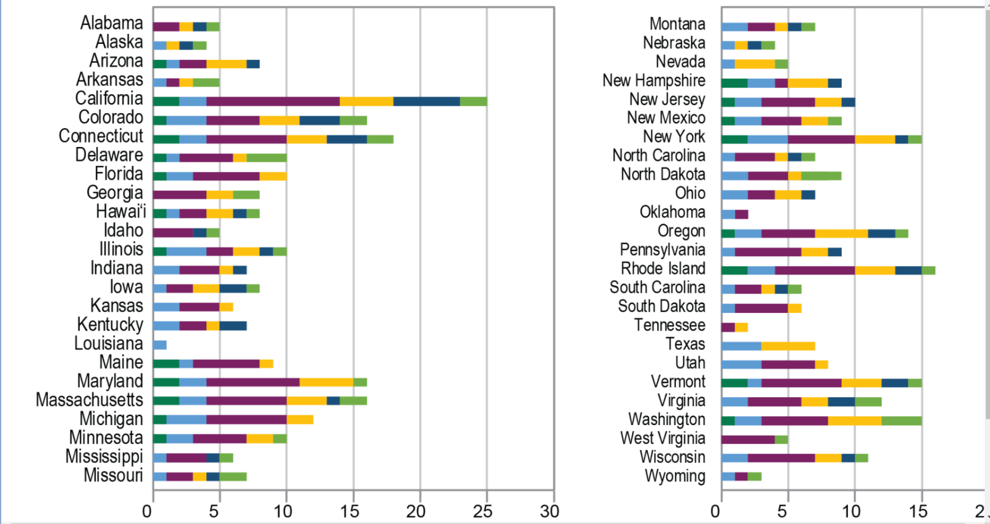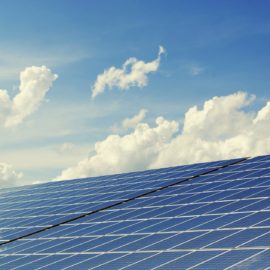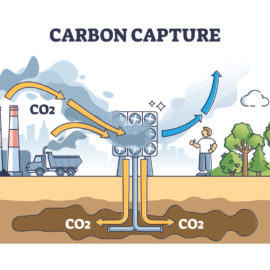
The governor is in Scotland and, for Louisiana, a lot is on the balance as we have a lot to lose, land included, if no real effort is made to combat climate change.
Gov. John Bel Edwards is in Scotland this week with an unusual sales pitch: Louisiana produces more greenhouse gas per capita, and stands to lose more from climate change, than any other state. Thus Louisiana is ripe for the world’s industry to invest in low- and no-carbon projects, even as the state remains a key source of oil and natural gas during the waning days of the globe’s carbon-based energy economy. “I’m going to Glasgow in order to concur with world leaders, but also very large corporations and other groups that are in this space, to make sure that they know if they want to make a profound difference in the short term, that they should come to Louisiana,” Edwards said of his visit to the United Nations’ annual climate conference. “And that we are going to be embracing cleaner energy alternatives to reduce our carbon footprint.” That shrinking will be conducted realistically, Edwards said, based on Louisiana’s history as a long-time carbon fuels energy producer. “There’s no doubt that the world is in a transition away from fossil fuels and towards cleaner, renewable energy sources that greatly reduce our carbon footprint,” Edwards said in an interview before flying to 26th annual Conference of Parties, known as COP26. “Even oil and gas companies – I don’t care which one you look at; it might be BP or Shell or Exxon – you can see that they are quickly rebranding. They don’t want to be known as oil and gas companies anymore. They want to be known as energy companies because the market is demanding cleaner energy going forward, and so they’re participating in this transition as well.” “I don’t believe the state of Louisiana can afford to be more pro-oil and gas than the oil and gas companies.”
nola.com
Now if the republicans in the legislature will agree. We can no longer sit on the sidelines with our heads buried in the sand. We are being hit now.
At the same time, he said, Louisiana can no longer afford to stand on the sidelines while the transition takes place, because of the increasing risks it faces from a rapidly changing climate. “There is no state more adversely affected by climate change than Louisiana in the country,” Edwards said. “And it manifests itself in things like sea level rise, the increasing frequency and severity of weather events like Laura, Delta, Ida. The two strongest hurricanes ever recorded happened in back to back years.” Edwards said the state also has an obligation because it produces more carbon dioxide per capita than any other state, largely the result of its myriad of oil refineries and chemical plants. But the transition to a clean-carbon future will take decades, he said, and the public should recognize that while it is occurring oil and natural gas produced in Louisiana or the Gulf of Mexico can still be sold as substitutes for more carbon-intensive fuels such as coal in the U.S. and around the world. “You’re not going to flip the switch and tomorrow get off of all fossil fuels,” Edwards said. “You’re going to continue to need natural gas. You’re going to continue to need oil. And given that reality, we might as well avail ourselves of the most carbon-advantaged barrel of oil in the world, which happens to come from the Gulf of Mexico.”
Edwards took his economic team with him and I hope they both learn and implement what they learn. He is right, it will be a long march but we have to start.
Edwards is traveling with Economic Development Secretary Don Pierson, Natural Resources Secretary Thomas Harris, eight staffers and a security unit. Unlike most other states, where transportation and electric power generation represent the largest sources of greenhouse gases, Louisiana’s industries, including refineries, petrochemical plants and steel manufacturing, accounted for 62% of the state’s emissions in 2018. That’s more than twice as high as the national average. Edwards or other state officials will be meeting with a number of international corporations, including Sasol, BASF, Drax, and Air Products, that already do business in Louisiana to discuss their present and potential future efforts to reduce those emissions, Pierson said. “Sasol has improved on its emissions reduction target for 2030, and will be at COP26, Pierson said. “BASF agrees that climate change is one of the most fundamental challenges of our time. BASF is committed to targets of the Paris Climate Agreement and is actively seeking to reduce greenhouse gas emissions by 25 percent by 2030.
Renewable energy is coming to the state and that will help.
“Drax, a provider of renewable energy, has very significant investments in Louisiana and is a company engaged at COP26, encouraging their continued investment in our state,” he said. Drax owns north Louisiana plants at Urania and near Bastrop to produce wood pellets from logs and wood products manufacturing waste. The pellets are shipped to Great Britain to fuel power plants. The company’s largest electric plant, in North Yorkshire, has been substituting the wood pellets for coal. The plant also has a test program underway for capturing carbon emissions from its exhaust and permanently storing them underground. The company contends that using renewable wood pellets, plus the carbon capture and storage, will eventually result in “negative” emission levels. In Scotland, the company also is producing fuel pellets from sewage sludge. Edwards said he would be meeting with Drax officials at one of their properties during the week of the conference.
While the delegates meet there will be companies selling their products and one will hope that they all will be “clean” companies.
Pierson said state officials will be meeting with Air Products representatives to discuss their plans to build a $4.5 billion plant in Ascension Parish. It is to produce “blue” hydrogen from natural gas, with a significant part of the investment used to capture and permanently dispose of carbon dioxide emissions in deep underground formations in five parishes. The product is called blue hydrogen to recognize its potential to reduce carbon emissions. In manufacturing the product, methane-dominated natural gas is split into hydrogen and carbon dioxide. The hydrogen is made into fuel, and the CO2, instead of being released as a greenhouse gas, is stored. This process has been criticized by environment advocates and some scientists as not really eliminating much greenhouse gases from the atmosphere, because other carbon dioxide is released in the steam that is used in the manufacturing process and because methane, a more intense greenhouse gas than carbon dioxide, is released during drilling and transport of natural gas. So-called “green” hydrogen uses electricity created from non-carbon sources such as wind, solar or nuclear power, to split water atoms into oxygen and hydrogen, which produces little carbon dioxide. Air Products, however, contends its process will eliminate 95% of the carbon dioxide involved through sequestration.
There is a lot at stake and we need to use proven ideas.
In the energy transition, Edwards said Louisiana can take advantage of an existing network of carbon dioxide pipelines to move the gas to various carbon capture locations in the state when they are developed. Louisiana is seeking authority from the U.S. Environmental Protection Agency to regulate the underground injection wells required for the capture process. Pierson said state officials also will be targeting software, technology and logistic companies with pitches to develop carbon-reduction projects in Louisiana.

GRAPHIC BY U.S. GLOBAL CHANGE RESEARCH PROGRAM
The advertisers at the meeting will will be showing off their wares and I am sure some will be entertaining.
COP26 includes both intergovernmental meetings aimed at setting world carbon reduction goals and side events that take on a circus-like trade show atmosphere, said David Reidmiller, who was the lead U.S. science and technology negotiator for the State Department for the 2015 Paris Agreement treaty on climate change. Speaking during a Local Media Association briefing on COP26 for reporters last week, Reidmiller said the two main goals of this year’s meeting will be to get national governments to commit to carbon reduction goals for 2030 and to agree to help fund carbon reduction efforts of less wealthy developing countries.

This is a follow-on to the Paris Accords which we rejoined after the last election. They have recently had a meeting and now this one will further set the stage for change.
The Paris Agreement set a worldwide goal of reducing emissions to net zero by 2050, aimed at limiting worldwide temperature increases to no more than 2 degrees Celsius, about 3.7 degrees Fahrenheit, with a goal of 1.5 degrees. The temperature increases are in comparison to world temperatures in 1850, about when the Industrial Revolution began spreading from England to the rest of the world. Scientists say that the rising temperatures are the result of increased amounts of carbon dioxide and so-called carbon-equivalent gases, such as nitrogen and methane, being released into the atmosphere by human activities, including transportation, industry and electric generation. The gases tend to trap heat in the atmosphere, which leads to warmer temperatures on Earth. That in turn causes ocean water molecules to swell in size, ice to melt into the oceans and the atmosphere to hold on to more moisture. The result has been rising sea levels; increased rainfall rates during hurricanes and thunderstorms; more intense storms; increases in drought conditions, wildfires and heat-related illnesses; and changes in growing seasons.
CPO26 is recognizing reality in their talks. This is a smart move and we have to start at where we are not where we wish we were.
The key issue that the COP26 delegates are to address is that based on current adopted policies, “We are likely locked into almost 3 degrees Celsius of warming,” Reidmiller said. Even with the unrealized commitments included in the Paris agreements and commitments made since then, the temperature increase drops to only 2.5 degrees Celsius. Worst-case scenarios that are included Louisiana’s Coastal Master Plan, based on just such high future temperatures, predict significant inundation of most remaining coastal wetlands and dry land outside of levees. Edwards said he will be giving at least one speech during the conference. On Friday, the 24-state U.S. Climate Alliance announced he’d also be participating in a panel discussion Tuesday with New Mexico Gov. Michelle Lujan Grisham, California Lt. Gov. Eleni Kounalakis and the White House national climate adviser, Gina McCarthy, and a second panel discussion Wednesday with the two state officials and U.S. climate envoy John Kerry. Details of his appearances remain sketchy, in part, because of COVID issues, including conference rules on who may attend meetings and the size of audiences in differing meeting spaces. Also attending the conference will be New Orleans Mayor LaToya Cantrell, who will speak at the opening of the U.S. Pavilion on Monday on the role of cities in addressing the climate crisis. On Wednesday, Cantrell will be speaking at a session titled “Investing in Net Zero: Overcoming the Challenges for Sustainable Finance and the Road to COP26.”
Louisiana will be well represented but the reality is that the opposition is strong and, while they are ignoring science, many are locked into our being an oil state regardless of the consequences. This needs to change.



